Intel Broadwell Architecture Preview: A Glimpse into Core M
by Ryan Smith on August 11, 2014 12:01 PM ESTPutting It All Together: Low Power Core M
So far we’ve discussed Broadwell’s architecture on a broad basis, focusing on features and optimizations that are fundamental to the architecture. However to talk about the Broadwell architecture is not enough to fully explain the Core M itself. Though many of Core M’s improvements do come from Broadwell, Intel has also made a number of alterations to everything from the CPU packaging to the process node itself specifically for Core M. It’s the resulting combination of these factors that has allowed Intel to iterate on Broadwell-Y over Haswell-Y, and why Intel is so confident in Broadwell-Y’s capabilities and suitability for mobile form factors.
When it comes to building and configuring Core M, Intel likes to refer to their efforts as the “Fanless Challenge,” reflecting the fact that their biggest goal with Core M is to comfortably get the processor in to 10” tablets under 10mm in thickness that are passively cooled. A big part of getting into such a device is meeting the heat dissipation limitations of the form factor – a 10” tablet under 10mm would require a sub-5W SoC – which is where a lot of Intel’s engineering efforts have gone. Broadwell’s performance optimizations, the GPU optimizations, GPU duty cycling, and the 14nm process all contribute to getting a Core CPU’s power consumption down to that level.
But even that’s still not enough, and for Core M Intel went so far as to give Broadwell-Y its own die and design a low-power optimized version of their 14nm process just for it. This variant is designed to further reduce power consumption by optimizing the resulting transistors for lower power, lower voltage, lower clockspeed operation. By doing this Intel was able to further reduce power consumption in all of the major areas over what would be a traditional 14nm Intel process.
In the resulting 14nm Broadwell-Y process, voltage, capacitance, and leakage were all improved over the traditional 14nm process. Capacitance was reduced by 15%, minimum operating voltages by 10%, and leakage was improved to the point that it reduced SoC power consumption by 10%. The combination of all of these factors serves to significantly lower power consumption over what Intel’s traditional 14nm process would provide.
Working in concert with Broadwell-Y’s 14nm process, Intel has made a number of other changes to further reduce power consumption. Some of these are reflected in Broadwell’s overall design and others are unique to Broadwell-Y, such as using a lower TjMax for Broadwell-Y. By reducing the maximum operating temperature of the chip Intel has been able to realize further power savings by further reducing voltage and decreasing the maximum amount of temperature-dependent leakage the SoC will experience.
Meanwhile Broadwell-Y’s partner in crime, the on-package PCH, has received its own optimizations to reduce power consumption on the SoC’s total power consumption. The PCH itself is not much of a power hog in the first place – it’s still made on Intel’s 32nm process for this and cost reasons – but with such a strong focus on power consumption every watt ends up counting. As a result the Broadwell PCH-LP has seen optimizations that cut its idle power consumption by 25% and its active power consumption by 20%. Further improvements to the PCH’s monitoring hardware also mean it’s more responsive and can be controlled to a finer degree than the Haswell PCH-LP, and Intel has upgraded to a faster audio DSP to improve performance and reduce power consumption there as well.
Feeding all of that silicon in turn is Intel’s second generation Fully Integrated Voltage Regulator (FIVR), which further builds off of Intel’s other optimizations. The 2nd gen FIVR has been tuned for Broadwell-Y’s lower voltages, making the FIVR itself more efficient when delivering power at those voltages. To accomplish this Intel has implemented non-linear vDroop control, which is designed to better control the voltage when workload changes would cause voltage overshoots that waste power. And when even the 2nd gen FIVR isn’t efficient enough, this latest FIVR offers a second mode (LVR Mode) for low voltage/workload situations where the FIVR can be partially bypassed to reduce the FIVR’s power consumption.
Interestingly Broadwell-Y also sees the voltage regulation inductors redesigned and relocated in both the name of power efficiency and space efficiency. We’ll get to the case of space efficiency in a moment, but for power efficiency the new 3D inductors (3DLs) have been placed on the underside of the package, allowing the use of more efficient inductors that waste less power.
This brings us to the final element of Intel’s power optimization efforts, which involve further adjustments to turbo boost as part of Intel’s “hurry up and go to sleep” motto. New for Broadwell-Y is a 3rd power state, PL3, which allows for even greater turbo boosting, but for only a very limited period of time – on the order of milliseconds. PL3 represents the maximum amount of power the device battery can deliver, and while it’s okay to reach this value sparingly, PL3 is a fast drain that is very hard on the battery. The existence of PL3 in this case is as much for battery protection as it is for performance; it allows devices to tap into PL3 power levels on occasion, all the while allowing PL2 (the regular burst limit) to be defined at a safer value below the battery’s limit. Put another way, by knowing PL3 devices know how to stay farther away from it, which in the long run is what’s best for battery reliability.


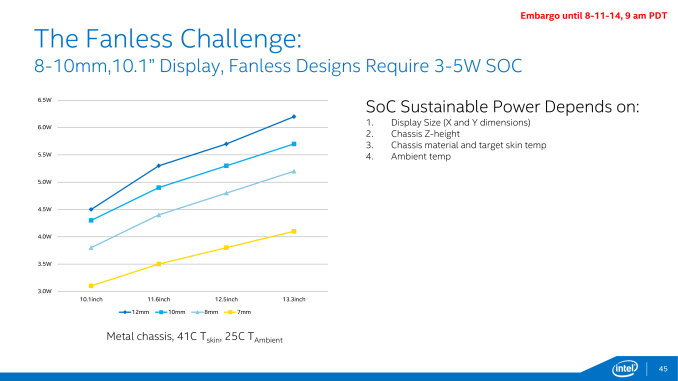
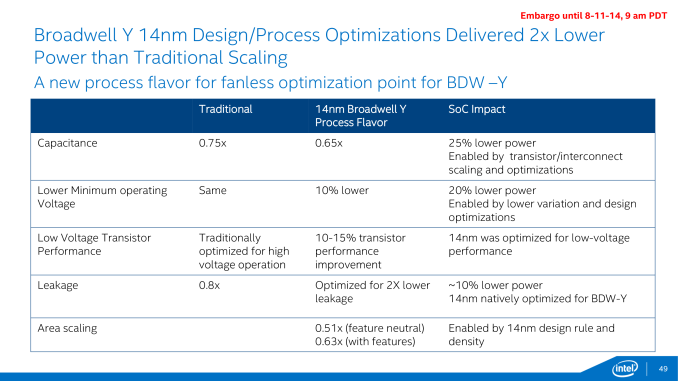
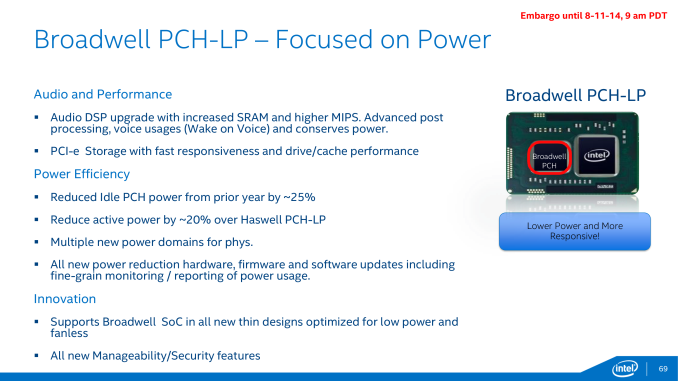
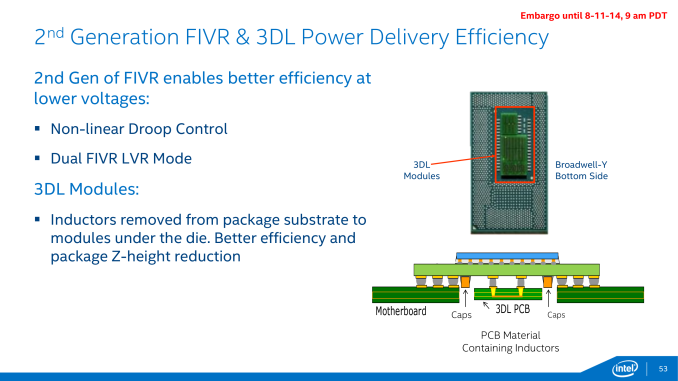

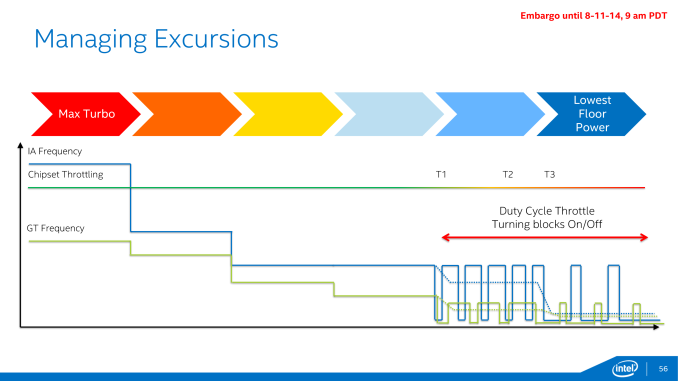








158 Comments
View All Comments
kyuu - Tuesday, August 12, 2014 - link
Nothing was said about cheap tablets in that quote, so I'm not sure why you're bringing up the price.Not that I disagree with your point. Of course, by continuing to focus on premium priced parts, Intel is never going to gain a profitable foothold in the mobile market. Core M needs to be cheaper, not just lower power, to be interesting. Otherwise there's no reason to care. If you're paying for a $1000 device, why do you want something that's obviously going to be so performance gimped compared to Y-series Broadwells?
Drazick - Tuesday, August 12, 2014 - link
Does "Shared Virtual Memory" means the same as AMD's shared memory configuration?No more need to replicate data for the GPU?
Laststop311 - Tuesday, August 12, 2014 - link
A surface Pro with core-M might be pretty good.Krysto - Tuesday, August 12, 2014 - link
For battery life, maybe. For performance, no.fokka - Tuesday, August 12, 2014 - link
i would like to see ordinary 13" ultrabooks with broadwell-y. don't make it too slim and see what performance and battery life is like with a 4.5w cpu. if performance is high enough for everyday tasks, it would really be nice to have slim notebooks approach 20 hours of battery life in light usage scenarios.but i guess companies will just use the low power cpus as an excuse to implement smaller batteries and 4k displays and we still won't get much more than 10h in best case scenarios...
dcaxax - Tuesday, August 12, 2014 - link
I'd argue that it may well be too late for Intel to enter this market, unless they can deliver a major step change in performance compared to ARM. Right now the ARM-Android & ARM-iOS ecosystems are well established and humming along nicely. On top of which tablet sales in the developed world are slowing down. The developing world is still growing but in those regions, cost will be a key factor.That leaves Intel targeting a market with an entrenched competitor, a set software ecosystems with no benefits from migrating to a new architecture (what do Apple, Google, Samsung, HTC, LG etc gain out of this?) and slowing hardware sales.
I Core M can deliver double performance for the same power draw AND price, then sure, I can see a rush to migrate to it, otherwise what's the point?
Krysto - Tuesday, August 12, 2014 - link
"Core" chips will never EVER compete with ARM in its main market. The best Intel can do is try to compete in $700+ devices. Core is just not competitive on price. Not even close. Period.Intel's only competition against ARM in the MOBILE market is Atom, and Nvidia's Denver is already TWICE as fast as that. Also Atom is twice as expensive as Denver, but Intel keeps subsidizing half the cost...for as long as they can, which probably won't be much longer.
tuxRoller - Wednesday, August 13, 2014 - link
Link to the denver benchmarks?Natfly - Tuesday, August 12, 2014 - link
This article feels like marketing drivel just listing point after point without any further explanation. I'd expect a little more in-depth analysis. Seriously a tick/tock chart?KhalidShaikh - Tuesday, August 12, 2014 - link
Great write up.